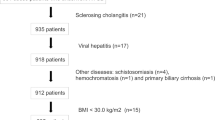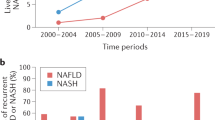Abstract
Background:
Bariatric surgery is performed safely in non-alcoholic fatty liver disease (NAFLD) patients with minimal fibrosis (stage 1–2). However, the safety and potential benefits of bariatric surgery for NAFLD with advanced fibrosis (stage 3–4) remain unclear. This study was designed to compare the safety and efficacy of bariatric surgery in patients with biopsy proven advanced fibrosis to those with minimal fibrosis.
Methods:
All patients who underwent bariatric surgery between 2005 and 2014 and had evidence of NAFLD with fibrosis score 3–4 (advanced fibrosis) based on the staging system defined by Kleiner et al. on intraoperative liver biopsy were included and compared with patients who had fibrosis score 1–2 (minimal fibrosis). The groups were compared for length of hospital stay after bariatric surgery and incidence of postoperative complications over a follow-up period of 1 year. An improvement in hepatic function tests before and 1 year after surgery was used as a parameter to evaluate for NAFLD improvement.
Results:
Ninety-nine patients with F3-4 (group 1) and 198 patients with F1-2 (group 2) were included. Mean age (51.9 vs 50.1 years) and body mass index (46.4 vs 46.5 kg m−2) were similar in the two groups. Median serum aspartate aminotransferase (43 vs 30 U l−1; normal 10–40 U l−1) and alanine aminotransferase (40.5 vs 34 U l−1; normal 10–50 U l−1) were significantly higher in group 1 and improved 1 year after surgery. Median length of hospital stay after surgery was higher in group 1 than that in group 2 (4 days vs 3 days; P-value=0.002). The proportion of patients developing postoperative complications over 1 year was similar in both groups (36.4% vs 32.8%; P-value=0.54).
Conclusions:
Advanced fibrosis does not increase the risk of developing postoperative complications in medically optimized patients undergoing bariatric surgery. Improvement in serum transaminase levels suggests a reduction in hepatic necroinflammatory activity following bariatric surgery.
This is a preview of subscription content, access via your institution
Access options
Subscribe to this journal
Receive 12 print issues and online access
$259.00 per year
only $21.58 per issue
Buy this article
- Purchase on Springer Link
- Instant access to full article PDF
Prices may be subject to local taxes which are calculated during checkout

Similar content being viewed by others
References
Sturm R, Hattori A . Morbid obesity rates continue to rise rapidly in the United States. Int J Obes 2013; 37: 889–891.
Flegal KM, Bit BK, Orpana H, Graubard BI . Association of all-cause mortality with overweight and obesity using standard body mass index categories: a systematic review and meta-analysis. JAMA 2013; 309: 71–82.
Shimizu H, Phuong V, Maia M, Kroh M, Chand B, Schauer PR et al. Bariatric surgery in patients with liver cirrhosis. Surg Obes Relat Dis 2013; 9: 1–6.
Clark JM . The epidemiology of nonalcoholic fatty liver disease in adults. J Clin Gastroenterol 2006; 40 (Suppl 1): S5–S10.
Kroh M, Liu R, Chand B . Laparoscopic bariatric surgery: what else are we uncovering? Liver pathology and preoperative indicators of advanced liver disease in morbidly obese patients. Surg Endosc 2007; 21: 1957–1960.
Adams TD, Gress RE, Smith SC, Halverson RC, Simper SC, Rosamond WD et al. Long-term mortality after gastric bypass surgery. N Engl J Med 2007; 357: 753–761.
Mathurin P, Hollebecque A, Arnalsteen L, Buob D, Leteurte T, Caiazzo R et al. Prospective study of the long-term effects of bariatric surgery on liver injury in patients without advanced disease. Gastroenterol 2009; 137: 532–540.
Mattar SG, Velcu LM, Rabinovitz M, Demetris AJ, Krasinskas AM, Barinas-Mitchell E et al. Surgically-induced weight loss significantly improves nonalcoholic fatty liver disease and the metabolic syndrome. Ann Surg 2005; 242: 610–617.
Chang SH, Stoll CR, Song J, Varela JE, Eagon CJ, Colditz GA . The effectiveness and risks of bariatric surgery: an updated systematic review and meta-analysis, 2003–2012. JAMA Surg 2014; 149: 275–287.
Mosko JD, Nguyen GC . Increased perioperative mortality following bariatric surgery among patients with cirrhosis. Clin Gastroenterol Hepatol 2011; 9: 897–901.
Dallal RM, Mattar SG, Lord JL, Watson AR, Cottam DR, Eid GM et al. Results of laparoscopic gastric bypass in patients with cirrhosis. Obes Surg 2004; 14: 47–53.
Weingarten TN, Swain JM, Kendrick ML, Charlton MR, Schroeder BJ, Lee RE et al. Nonalcoholic steatohepatitis (NASH) does not increase complications after laparoscopic bariatric surgery. Obes Surg 2011; 21: 1714–1720.
Rebeireiro T, Swain J, Sarr M, Kendrick M, Que F, Sanderson S et al. NAFLD and insulin resistance do not increase the risk of postoperative complications among patients undergoing bariatric surgery—a prospective analysis. Obes Surg 2011; 21: 310–315.
Kleiner DE, Brunt EM, Nan Natta M, Behling C, Contos MJ, Cummings OM . Design and validation of a histological scoring system for nonalcoholic fatty liver disease. Hepatology 2005; 41: 1313–1321.
Livingston EH, Huerta S, Arthur D, Lee S, De Shields S, Heber D . Male gender is a predictor of morbidity and age a predictor of mortality for patients undergoing gastric bypass surgery. Ann Surg 2002; 236: 576–582.
Fernandez AZ Jr, Demaria EJ, Tichansky DS, Kellum JM, Wolfe LG, Meador J et al. Multivariate analysis of risk factors for death following gastric bypass for treatment of morbid obesity. Ann Surg 2004; 239: 698–702.
James PA, Oparil S, Carter BL, Cushman WC, Dennison-Himmelfarb C, Handler J et al. Evidence-based guidelines for the management of high blood pressure in adults: report from the panel members appointed to the Eighth Joint National Committee (JNC 8). JAMA 2014; 311: 507–520.
Elnahas A, Nguyen GC, Okrainec A, Qureshy F, Jackson TD . The effect of underlying liver disease on short-term outcomes following bariatric surgery. Surg Endosc 2014; 28: 2708–2712.
Macaron C, Hanouneh IA, Suman A, Lopez R, Johnston D, Carey WW . Safety of cardiac surgery for patients with cirrhosis and Child-Pugh score less than 8. Clin Gastroenterol Hepatol 2012; 10: 535–539.
Boza C, Gamboa C, Salinas J, Achurra P, Vega A, Perez G . Laparoscopic Roux-en-Y gastric bypass versus laparoscopic sleeve gastrectomy: a case–control study and 3 years of follow-up. Surg Obes Relat Dis 2012; 8: 243–249.
Dixon JB, Bhathal PS, O’Brien PE . Weight loss and non-alcoholic fatty liver disease: falls in gamma-glutamyl transferase concentrations are associated with histological improvement. Obes Surg 2006; 16: 1278–1286.
Pestana L, Swain J, Dierkhising R, Kendrick ML, Kamath PS, Watt KD . Bariatric surgery in patients with cirrhosis with and without portal hypertension: a single-center experience. Mayo Clin Proc 2015; 90: 209–215.
Mofrad P, Contos MJ, Haque M, Sargeant C, Fisher RA, Luketic VA et al. Clinical and histologic spectrum of nonalcoholic fatty liver disease associated with normal ALT values. Hepatology 2003; 37: 1286–1292.
Dixon JB, Bhathal PS, Hughes NR, O’Brien PE . Nonalcoholic fatty liver disease: Improvement in liver histological analysis with weight loss. Hepatology 2004; 39: 1647–1654.
Lassailly G, Caiazzo R, Buob D, Pigeyre M, Verkindt H, Labreuche J et al. Bariatric surgery reduces features of nonalcoholic steatohepatitis in morbidly obese patients. Gastroenterology 2015; 149: 379–388.
Furuya CK Jr, de Oliveria CP, de Mello ES . Effects of bariatric surgery on nonalcoholic fatty liver disease: preliminary findings after 2 years. J Gastroenterol Hepatol 2007; 22: 510–514.
Liu X, Lazenby AJ, Clements RH, Jhala N, Abrams GA . Resolution of nonalcoholic steatohepatitis after gastric bypass surgery. Obes Surg 2007; 17: 486–492.
Acknowledgements
Dr Schauer receives grants from Eithcon, Medtronics, Pacira, consults for Ethicon and The Medicines Company and owns stock for Surgiquest SE HQC LLC. None of the other authors have financial affiliations to disclose. This study was supported in part by NIH Grant UDK 505.
Author information
Authors and Affiliations
Corresponding author
Ethics declarations
Competing interests
The authors declare no conflict of interest.
Rights and permissions
About this article
Cite this article
Singh, T., Kochhar, G., Goh, G. et al. Safety and efficacy of bariatric surgery in patients with advanced fibrosis. Int J Obes 41, 443–449 (2017). https://doi.org/10.1038/ijo.2016.212
Received:
Revised:
Accepted:
Published:
Issue Date:
DOI: https://doi.org/10.1038/ijo.2016.212
This article is cited by
-
Surgical risk stratification in patients with cirrhosis
Hepatology International (2024)
-
Current Controversies in Metabolic Surgery for Nonalcoholic Fatty Liver Disease
Obesity Surgery (2019)
-
Comparison of Early Morbidity and Mortality Between Sleeve Gastrectomy and Gastric Bypass in High-Risk Patients for Liver Disease: Analysis of American College of Surgeons National Surgical Quality Improvement Program
Obesity Surgery (2018)



